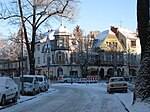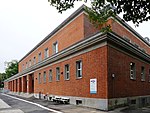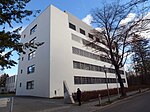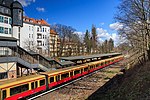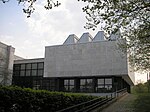Berlin-Lichterfelde West station
Berlin S-Bahn stationsBerlin S-Bahn stubsBerlin railway station stubsBuildings and structures in Steglitz-ZehlendorfPages with no open date in Infobox station ... and 2 more
Railway stations in BerlinRailway stations in Germany opened in 1872

Berlin-Lichterfelde West (in German Bahnhof Berlin-Lichterfelde West) is a railway station in Lichterfelde West, within the district of Lichterfelde (Steglitz-Zehlendorf) in Berlin, Germany. It is served by the Berlin S-Bahn and several local bus lines. The station was built in 1872 in the style of a Tuscan villa as a train station for the elegant development of Villenkolonie Lichterfelde West, a newly created expensive residential area for wealthy Berliners. From 1946 until 1993 Lichterfelde West was the terminus of the Duty-Train of the United States Forces in Berlin.
Excerpt from the Wikipedia article Berlin-Lichterfelde West station (License: CC BY-SA 3.0, Authors, Images).Berlin-Lichterfelde West station
Hans-Sachs-Straße, Berlin Lichterfelde
Geographical coordinates (GPS) Address Nearby Places Show on map
Geographical coordinates (GPS)
| Latitude | Longitude |
|---|---|
| N 52.443333333333 ° | E 13.294722222222 ° |
Address
Bahnhof Lichterfelde West
Hans-Sachs-Straße
12205 Berlin, Lichterfelde
Germany
Open on Google Maps
